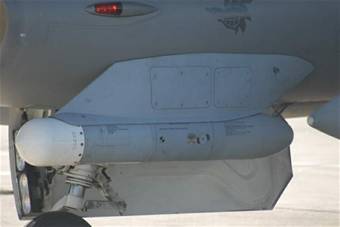HIGH-SPEED ANTI-RADIATION MISSILE TARGETING SYSTEM
Posted 10/18/2007
 Printable Fact Sheet
Printable Fact Sheet
| |
| Photos | |
 |
The High-speed Anti-Radiation Missile Targeting System, or HTS, loaded on the F-16CJ Block 50/52 Fighting Falcon at Langley Air Force Base, Va. (Courtesy photo)
|
Download HiRes
|
|
|
|
|
Mission
The High-speed Anti-Radiation Missile Targeting System, or HTS, is a system for use on the Air Force's F-16CJ Block 50/52 Fighting Falcon. This targeting system is the cornerstone of the suppression of enemy air defense mission, providing substantial situational awareness to pilots on the types and locations of surface-to-air defense radars, as well as passing ranging solutions to the HARM missile when launched.
Features
The HTS system consists of the pod, the High-speed Anti-Radiation Missile, or HARM, the aircraft launcher interface computer, and HTS-unique F-16 software. The pod is mounted externally on the right engine inlet hardpoint for the release 6, or R6, pod and the left engine inlet hardpoint for the release 7, or R7, pod.
The current configurations are R6 and R7 pods. R7, a hardware and software retrofit to the R6, provides precision targeting for various precision guided munitions, or PGMs, to support the destruction of enemy air defenses mission. The retrofit is on-going and all R6 to R7 upgrades should be completed by the end of 2008.
The HTS system provides an all-weather detection and identification of enemy air defense radars. The aircraft displays the type, range and bearing of threat radars to the pilot. During flight, the pilot can adjust the search volume and radio frequency scan to optimize detection and ranging performance.
Pilots designate targets on the HARM Attack Display for launch. Upon firing, the HTS derived target information is sent to the HARM missile. The precision targeting capability of the R7 pod allows employment of various PGMs using an aircraft datalink system to quickly identify and target threats from any PGM-carrying platform on the network. Pilots can also datalink precision targeting coordinates to other F-16s or to the RC-135 Rivet Joint.
Background
HTS was developed to fill the void left from the deactivation of the F-4G Wild Weasel. The original contract was awarded to Texas Instruments Corp. (now Raytheon Systems Company) in 1991. The initial operational capability of the first squadron was declared in 1994. The Air Force has continued to purchase additional quantities of HTS pods and now plans to purchase pods to support the entire F-16 Block 50/52 fleet.
The original HTS pod was upgraded in 1996 with a software Release 5, which vastly increased ranging speed and improved threat identification. R6 increased frequency coverage, search speed, number of targets tracked, and identification capabilities, and was fielded in May 2000. The latest software and hardware revision, known as R7, increases frequency coverage, search speed, number of targets tracked and identification capabilities, adds precision targeting and was fielded in September 2006.
The R6 upgrade has received a significant level of interest since Operation Desert Storm. Two F-16CJ aircraft with R6 pods were used along with a Navy P-3 Orion aircraft in a joint demonstration in November 2000. The HTS continues to be evaluated as a system to assist in time critical targeting, or TCT, which has Department of Defense interest. The joint demonstration proved that TCT could be accomplished today if employed with precision coordinates provided in a timely manner to meet TCT mission requirements.
The R7 pod provides the Air Force more accurate and timely targeting, and offers improved capabilities for joint TCT missions. R7 employs a new digital receiver and GPS hardware capability, along with using Link-16 connectivity between aircraft, which will allow precision targeting solutions to potentially any PGM requiring GPS accuracy; such as, joint direct attack munitions, joint air-to-surface standoff missiles. The retrofit to R7 pods is expected to be complete by 2008.
General Characteristics
Primary function: Detection, identification, and ranging of air defense radars
Contractor: Raytheon Systems Company, Inc.
Length: 56 inches (1.42 meters)
Diameter: 8 inches (.20 meters)
Weight: R6, 82.5 pounds (37.7 kilograms); R7, 100 pounds (45 kilograms)
Aircraft: F-16CJ (Block 50/52)
Sensors: Interferometer based
Unit cost: Not available
Initial operating capability: March 1994
Inventory: Not available
Point of Contact
Air Combat Command, Public Affairs Office; 130 Andrews St., Suite 202; Langley AFB, VA 23665-1987; DSN 574-5007 or 757-764-5007; e-mail: accpa.operations@langley.af.mil
|  |



